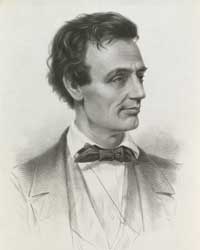The Rise of Lincoln
Abraham Lincoln represented the new man of the American West, and his rise to the presidency is an unprecedented story of personal ambition combining with historical circumstances. Born poor, self-taught, and preternaturally driven to leave his mark on his country, Lincoln emerged on the political landscape in the 1850s as a representative of ambitious men on the make. Coalescing around an ideology of free labor, Lincoln and like-minded men founded the Republican Party to fill the vacuum left with the collapse of the national Whig and Democratic parties over the issue of slavery. Lincoln, gawky and awkward in his personal appearance, emerged as the unlikely standard-bearer of the Republicans. His finely honed intelligence, his political acumen, and his sense that he spoke for—indeed embodied—the Union, made Lincoln one of the most charismatic and powerful figures in American history.
| Continue to The Civil War |









